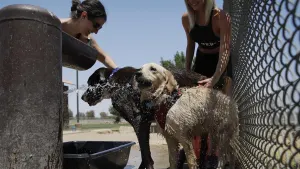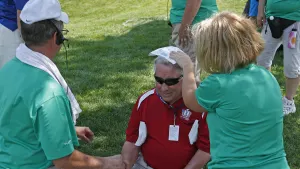Spent some time in the sun? Here are 18 tips to treat sunburn in adults and children
Spent some time in the sun? Here are tips to treat sunburn in adults and children.
•
May 26, 2023, 8:30 AM
•
Updated 279 days ago
Share:
More Stories
1:32

8 tips for working safely during hot weather
261ds ago9:43:53

12 tips to help keep your pets cool during the dog days of summer
261ds ago14:52:13

13 cool tips to help you stay healthy during the summer heat
261ds ago3:39

Safety tips: Know the signs of heat exhaustion and heat stroke
261ds ago
Love spending time in the sun? Here are 6 tips to protect your skin from sunburn
278ds ago0:27

12 tips to avoid getting caught in a rip current
565ds ago1:32

8 tips for working safely during hot weather
261ds ago9:43:53

12 tips to help keep your pets cool during the dog days of summer
261ds ago14:52:13

13 cool tips to help you stay healthy during the summer heat
261ds ago3:39

Safety tips: Know the signs of heat exhaustion and heat stroke
261ds ago
Love spending time in the sun? Here are 6 tips to protect your skin from sunburn
278ds ago0:27

12 tips to avoid getting caught in a rip current
565ds ago
Sunburn is not immediately apparent. Symptoms usually start about 4 hours after sun exposure, worsen in 24-36 hours, and resolve in 3-5 days, according to the Centers for Disease Control and Prevention.
Symptoms may include - Red, warm, tender and swollen skin, blistering, headache, fever, nausea and fatigue. The pain from sunburn is worse 6-48 hours after sun exposure. Skin peeling usually begins 3-8 days after exposure.
If you, or your child become sunburned, follow these guidelines:
ADULTS
1. Symptoms can be treated with aspirin, acetaminophen, or ibuprofen to relieve pain and headache and reduce fever.
2. Drinking plenty of water helps to replace fluid losses.
3. Cool baths or the gentle application of cool wet cloths on the burned area may also provide some comfort.
4. Workers with sunburns should avoid further exposure until the burn has resolved.
5. Additional symptomatic relief may be achieved through the application of a topical moisturizing cream, aloe, or 1% hydrocortisone cream. A low-dose (0.5%-1%) hydrocortisone cream, which is sold over the counter, may be helpful in reducing the burning sensation and swelling and speeding up healing.
6. If blistering occurs, lightly bandage or cover the area with gauze to prevent infection.
7. Blisters should not be broken, as this will slow the healing process and increase the risk of infection.
8. When the blisters break and the skin peels, dried fragments may be removed and an antiseptic ointment or hydrocortisone cream may be applied.
9. Seek medical attention if any of the following occur:
- Severe sunburns covering more than 15% of the body;
- Dehydration;
- High fever (>101°F);
- Extreme pain that persists for longer than 48 hours.
CHILDREN
Babies under 6 months of age should never be exposed to the sun. Babies older than 6 months should be protected from the sun, and wear UV-blocking sunglasses to protect their eyes.
10. Bathe in clear, tepid water to cool the skin.
11. For a baby less than 1 year old, sunburn should be treated as an emergency. Call your doctor immediately.
12. For a child 1 year or older, call your doctor if there is severe pain, blistering, lethargy or fever over 101°F.
13. Sunburn can cause dehydration. Give your child water or juice to replace body fluids. Contact the doctor if the child is not urinating regularly; this is an emergency.
14. Apply light moisturizing lotion to soothe the skin, but don’t rub it in. Dabbing on plain calamine lotion may help, but don’t use one with an added antihistamine.
15. Do not apply alcohol, which can overcool the skin.
16. Do not use any medicated cream such as hydrocortisone or benzocaine unless instructed by your pediatrician.
17. Keep your child out of the sun entirely until the sunburn heals.
18. Practice sun protection and make sure that no matter where you child goes, sun safety is taken into account.
More from News 12
5:08

be Well: Easy-to-make, delicious and healthy meatballs

Your Road Trip Close to Home adventure guide for March 27
2:39

be Well: Top book picks for kids of all ages
2:29

8 tips to cope with seasonal allergies

Your Road Trip Close to Home adventure guide for March 20
